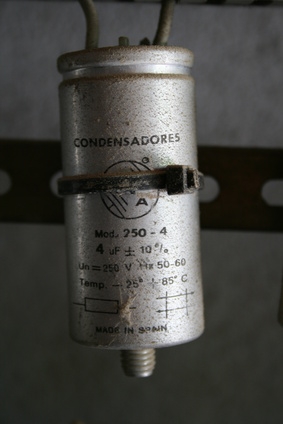
The capacitor on an electric motor works something like a battery, storing energy in the form of electricity. Occasionally referred to as a condenser, a capacitor is a passive (giving no energy) component used in many electrical devices. Typically capacitors are found on single-phase motors and are used for starting and running the motor. Single-phase motors with capacitors can generally be found in HVAC (heating ventilation and air conditioning) units, air compressors or any other device requiring increased starting torque.
Records indicate the capacitor was invented in 1745 by a German scientist named Ewald Georg von Kleist. Many months later a Dutch professor at the University of Leyden, Pieter van Musschenbroek, invented a similar device called the "Leyden jar." The Leyden jar generally is credited with being the first capacitor. Eventually both scientists were given equal credit for inventing the capacitor.
There are two common types of electric motor capacitors: a start capacitor and a run capacitor. A run capacitor will increase the run efficiency of a motor and is designed for nonstop duty, remaining energized the whole time the motor is running. A start capacitor adds a boost in torque during the initial start of an engine. Start capacitors allow an electric motor to be cycled off and on quickly, remaining energized for the length of time needed to rapidly take the motor to three-quarters of full speed. The start capacitor is then removed from the circuit or disengaged.
In its simplest form a capacitor is made up of two parallel plates that act as electrical conductors. The two plates are not connected but are separated by a space (air) or by an insulating material (does not conduct electricity) called the dielectric. Most often the dielectric is made from nonconductive materials best suited to the capacitor's particular function. Ceramic, cellulose, mica, Mylar, Teflon and porcelain are examples of materials used. The dielectric determines the type and task of a capacitor.
Although a capacitor is comparable to a battery, an important difference is their rate of discharge. A battery may take several minutes to completely discharge, whereas a capacitor is capable of dumping its entire charge in a fraction of a second. For this reason, great care must be taken when working with capacitors. Especially large, fully-charged capacitors can be deadly.
In some cases, capacitors are used to store just enough of a charge for rapid release, as with a camera flash. If a line that carries DC (direct current) voltage contains spikes and waves, a capacitor can even out the voltage by filling in the valleys and absorbing the peaks. A capacitor can also be used to block DC voltage altogether, but an AC (alternating current) signal can flow through a capacitor unhindered.